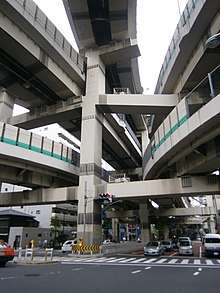Mukojima Route
The Mukojima Route (向島線, Mukojima-sen), signed as Route 6, is one of the tolled routes of the Shuto Expressway system serving the Greater Tokyo Area. It is one two expressways signed as Route 6 in the system, the other expressway signed as Route 6 is the Misato Route. The route is a 10.5-kilometer (6.5 mi) long radial highway running northeast from Chūō City to Katsushika. It connects Tokyo's Inner Circular Route in central Tokyo to the Central Circular Route and the Misato Route, which eventually leads to the Jōban Expressway that connects the Kantō region to the Tōhoku region.
| |
|---|---|
| Route information | |
| Length | 10.5 km (6.5 mi) |
| Existed | 1971–present |
| Major junctions | |
| South end | Edobashi Junction in Chūō City |
| North end | Horikiri Junction in Katsushika |
| Highway system | |
| National highways of Japan Expressways of Japan | |
Route description

Route 6 begins at Edobashi Junction with the Inner Circular Route in Chūō City above Nihonbashi, Japan's kilometre zero. From there it travels northeast through Sumida before crossing over the Arakawa River into Katsushika where Route 6 ends at Horikiri Junction with the northeastern section of the Central Circular Route.[1]
The speed limit on the Mukojima Route is set at 60 km/h.[2]
History
The first section of the Mukojima Route between the expressway's southern terminus at Edobashi Junction and Mukojima, was opened to traffic on 21 March 1971. Hakozaki Junction, where the expressway meets the Fukagawa Route, was opened on 5 February 1980. The final section of the expressway between Mukojima and its northern terminus at Horikiri Junction was opened on 30 March 1982.[3]
Junction list
| Location | km | mi | Exit | Name | Destinations | Notes | |
|---|---|---|---|---|---|---|---|
| Chūō | 0.0 | 0.0 | — | Edobashi | Southern terminus | ||
| 0.8 | 0.50 | 601, 602 | Hakozaki | ||||
| 0.8– 0.9 | 0.50– 0.56 | 602, 604 | Hamachō | Shin-Ōhashi-dōri | |||
| 0.9 | 0.56 | 603 | Kiyosubashi | Kiyosubashi-dōri | |||
| 2.1 | 1.3 | — | Ryōgoku | Northbound exit, southbound entrance | |||
| Sumida | 4.0 | 2.5 | 605 | Komagata | Northbound exit, southbound entrance; parking area for southbound traffic | ||
| 6.2– 6.3 | 3.9– 3.9 | 606, 607 | Waseda | Tokyo Metropolitan Route 461 (Bokutei-dōri) – Mukojima, Kototoi Bridge, Tokyo Skytree | |||
| 7.5– 8.5 | 4.7– 5.3 | 609, 610 | Tsutsumidōri | Keyaki-dōri – Bokutei-dōri, Senju | |||
| Katsushika | 9.5 | 5.9 | — | Horikiri | Northern terminus | ||
1.000 mi = 1.609 km; 1.000 km = 0.621 mi
| |||||||
See also


References
- "路線から出入口を探す" (in Japanese). Metropolitan Expressway Company Limited. Retrieved 28 September 2019.
- "Tokyo Shutoko Expressway: Japan's Busiest Road Network". Retrieved 28 September 2019.
- "首都高の歴史". Metropolitan Expressway (in Japanese). Retrieved 7 November 2019.
External links

